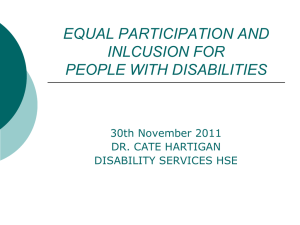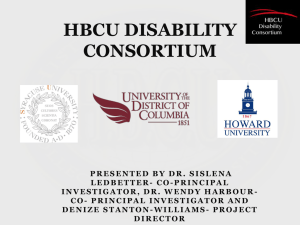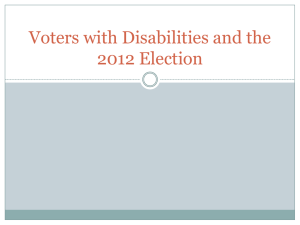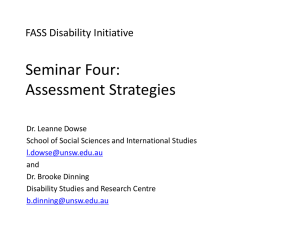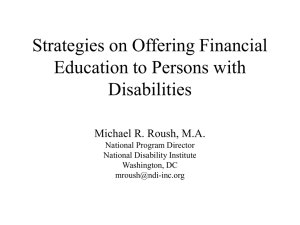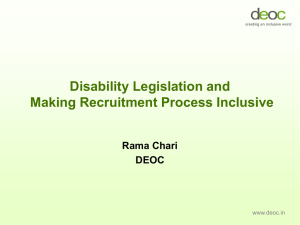Financial Education for Persons with Disabilities
advertisement
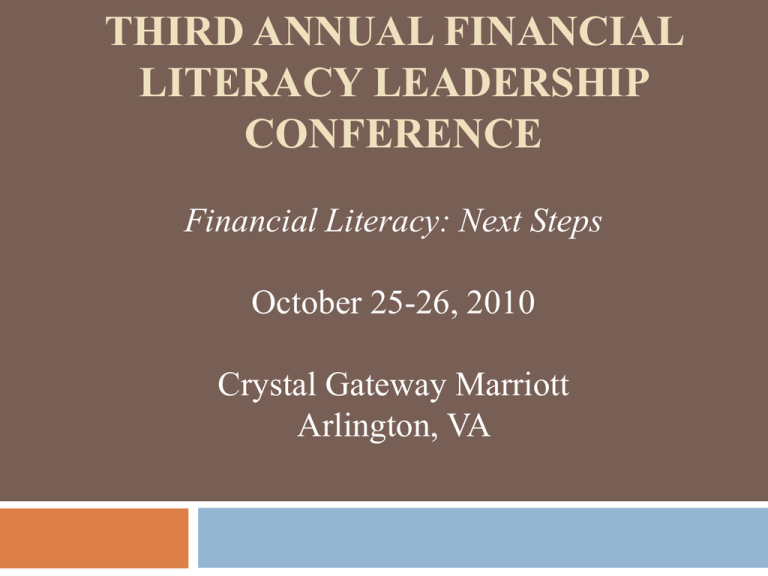
THIRD ANNUAL FINANCIAL LITERACY LEADERSHIP CONFERENCE Financial Literacy: Next Steps October 25-26, 2010 Crystal Gateway Marriott Arlington, VA FINANCIAL EDUCATION FOR PERSONS WITH DISABILITIES Michael Morris, J.D. Executive Director National Disability Institute, Washington, DC And Chief Executive Officer (CEO) Burton Blatt Institute Syracuse University mmorris@ndi-inc.org Learning Objectives Demographics Why is Financial Education Important for Persons with Disabilities? Tips for Implementing Curriculum Resources and Tools Best Practices from the Field National Disability Institute A national research and development organization with the mission to promote income preservation and asset development for persons with disabilities and to build a better economic future for Americans with disabilities. 5 “About 44 million Americans – one in seven – lived last year in homes in which the income was below the poverty level, which is about $22,000 for a family of four. This is the largest number of people since the Census began tracking poverty 51 years ago.” Washington Post, September 17, 2010 6 For individuals with disabilities, current state of income that falls below the poverty level is at least double when compared to their non disabled peers (28% versus 14%) 7 No group in America is more in need and more deserving of economic recovery Americans with Disabilities Act Definition The term "disability" means, with respect to an individual (A) a physical or mental impairment that substantially limits one or more major life activities of such individual; (B) a record of such an impairment; or (C) being regarded as having such an impairment Disability Demographics Demographics 54 million people 22 million families Employment 22 million working age 7.6 million working Geography 15% in the Northeast 31% in the South 28% Midwest 16% West Ethnicity 12.7% White 17.5% Black/African American 21.7 Native American 6.3% Asian/Pacific Rim 11.9% Other -- Cornell 2009 Disability Status Report One in five adults living in the US have a disability. Three times more likely than their peers without a disability to live at or below the poverty line. Dependence on public benefits for income, health care, food, and housing becomes a trap that requires staying poor to stay eligible Complex public benefit system Enduring Poverty and Lack of Economic Empowerment Diminishes freedom Limits opportunity Stifles self-determination Why is Economic Empowerment Important? Impact mental and physical health. Impact positively self-concept. Change status with other community stakeholders. Directly impacts quality of life. New Agenda – New Thinking Institutions to Community Living Special Schools to Public Education Income Maintenance to Employment Individual Plans to Self-Directed Accounts Economic Insecurity to Full Citizenship Building a Roadmap out of Poverty must include Financial Education. Tools and Strategies For A Better Future Financial Literacy Income Production and Preservation Matching Savings Use of Work Incentives Microenterprise Development and Home Ownership Blending of Public and Private Resources Use of Favorable Tax Provisions Family Self-Sufficiency Housing Choice Vouchers 15 For people with disabilities, there is a new level of focus, energy, and commitment to build a roadmap out of poverty at a national, state, and local level. 16 New Focus New Tools and Strategies New Partnerships Focus on Economic Empowerment 17 Cross agency collaboration to remove policy and program barriers to selfsufficiency Increase awareness and understanding of ways social insurance, employment, and asset development programs work together rather than in conflict Focus on Economic Empowerment 18 Empower persons with disabilities with new knowledge, choices, and supports Pilot, demonstrate, document, and disseminate success at an individual and systems level New Partnerships 19 Establish community-wide savings and asset building work groups Build a bridge across disability and nondisability, public and private, for profit and not for profit entities New Partnerships 20 Mayor’s Offices United Way IRS FDIC IDA Providers EITC Coalitions Financial Institutions Microenterprise Lenders Home Ownership and Credit Counseling Programs DD Council VR Agency Social Security Field Office WIPA Grantees Peer Support Groups Centers for Independent Living OMH Community Action Agencies 21 PURPOSE Build disability inclusive free tax assistance through trusted networks OUTCOMES Growing awareness that disability is a key component of diversity New income poverty research linked to disability ACTIVITIES •Create disability workgroups within free tax coalitions •Design free tax services and products that are accessible across the disability continuum •Create volunteer tax modules that address serving taxpayers with disabilities •Hold asset summits to introduce disability community to financial community •Provide benefits education about receipt of public benefits and tax credits 22 REI Tour Outcomes 23 YEAR RETURNS PREPARED TAX REFUNDS RECEIVED $$ SAVED CITIES PARTNERS 2005 11 ----- 7,600 $6.8 mil $1.5 mil 2006 30 200 17,223 $15.3 mil $3.4 mil 2007 54 355 36,275 $32.6 mil $7.2 mil 2008 62 555 90,653 $81.0 mil $18.1 mil 2009 84 634 181,152 $176.6 mil $36.2 mil 2010 100 710 360,499 $351.5 mil $72.0 mil 693,402 $663.8 mil $138.4 mil TOTAL: Financial Education & Persons with Disabilities Little federal or private attention has been given to the study of financial education for persons with disabilities. Financial education is understudied, un-funded and mainly unrecognized as a piece of the puzzle in reducing poverty and building economic independence and self-sufficiency for working adults with disabilities. TaxFacts+ Campaign found that only 21 percent of 649 working individuals earning $35,000 or less had participated in a class or workshop on how to handle their money. Participants reported teaching material used for financial education was not understandable or accessible. Financial Education for Individuals, Families, and Employers Need a framework for building financial relationships with non-traditional partners in the community. Professionals in financial services need education about the specific needs of individuals with disabilities on public benefits who are working. Employers of individuals with disabilities need information and guidance in assisting workers with various options for employee benefits Inclusive not Unique Curriculum Designing separate curriculum is not necessary. So what is necessary? Enduring individuals with disabilities receive the same educational benefit as those served without disabilities. Creating an inclusive environment that is empowering, disability sensitive, and solution oriented. Indicators of an Inclusive Environment Spirit of Inclusion Barrier Free Environment Accessible Communications Options Absence of Program Barriers Utilization of Community Resources NDI’s Accessible Financial Literacy checklist: www.realeconomicimpact.org/data/files/other%20doc uments/Accessible_FL_Checklist.doc Practical Application Disability Etiquette & Use People First Language Complex roadmap in navigating public benefit system – important to be mindful of this Relevant topics to individuals ex. 401 K may not be as important due to resource limits Be creative and make it interactive Incorporate financial institutions and nontraditional partners in the delivery of the curriculum Make materials accessible People First Language Positive language empowers. When writing or speaking about people with disabilities, it is important to put the person first. Group designations such as "the blind," "the retarded" or "the disabled" are inappropriate because they do not reflect the individuality, equality or dignity of people with disabilities. Further, words like "normal person" imply that the person with a disability isn't normal, whereas "person without a disability" is descriptive but not negative. Making Materials Accessible & Providing Accommodations Alternative Formats (examples) Braille Large print Accommodations (examples) American Sign Language Interpreters Additional time for tests Reading questions aloud Technology (examples) Screen readers Closed captioning for videos Resources Accommodations and Disability Etiquette ADA National Technical Assistance Center (free personalized assistance to understand and implement the ADA) – www.adata.org/Static/Home.aspx General Tips for Communicating with People with Disabilities – www.earnworks.com/docs/FactSheets/.../FS-ERCommunicating.pdf “At Your Service: Welcoming Customers with Disabilities” (self-paced web course) – www.wiawebcourse.org Job Accommodation Network – www.jan.wvu.edu Resources Financial Literacy VISA Financial Soccer (REI Tour version) – www.realeconomicimpact.org Practical Money Skills for Life – www.practicalmoneyskills.com/games Economic Empowerment National Disability Institute – www.realeconomicimpact.org Equity Newsletter – www.wid.org/programs/access-toassets/equity “My American Dream seems simple: to live on my own and be self-sufficient, to live with dignity and independence. I struggle with my finances right now, but I am an optimist – I believe that I can make progress with my job, move forward and become part of the mainstream economy and achieve my goals.” Cynthia Battles 2008 REI Tour Adult Blogging Contest Winner Rutland, VT

